13.4 Fungi
Learning Objectives
By the end of this section, you will be able to:
- List the characteristics of fungi
- Describe fungal parasites and pathogens of plants and infections in humans
- Describe the importance of fungi to the environment
- Summarize the beneficial role of fungi in food and beverage preparation and in the chemical and pharmaceutical industry
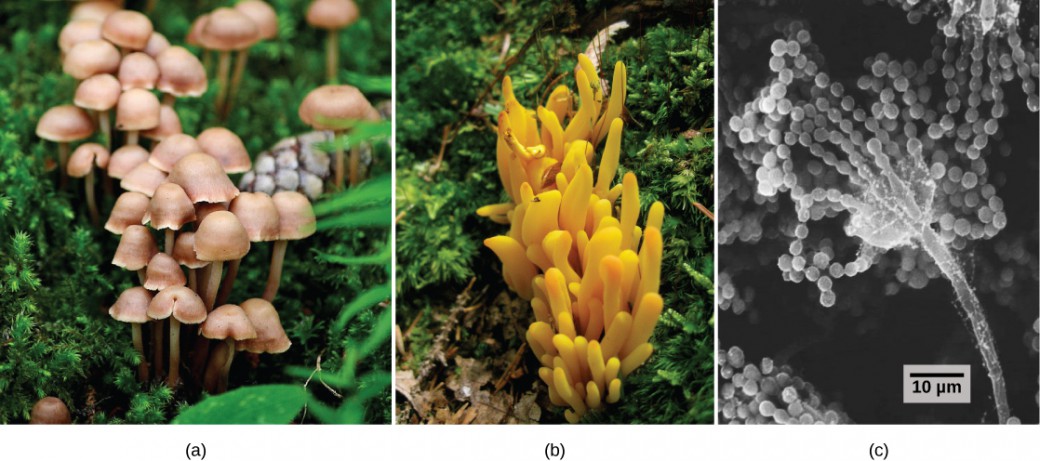
The word fungus comes from the Latin word for mushroom. Indeed, the familiar mushrooms are fungi, but there are many other types of fungi as well (Figure 13.20). The kingdom Fungi includes an enormous variety of living organisms collectively referred to as Eumycota, or true fungi. While scientists have identified about 100,000 species of fungi, this is only a fraction of the over 1 million species likely present on Earth. Edible mushrooms, yeasts, black mold, and Penicillium notatum (the producer of the antibiotic penicillin) are all members of the kingdom Fungi, which belongs to the domain Eukarya. As eukaryotes, a typical fungal cell contains a true nucleus and many membrane-bound organelles.
Fungi were once considered plant-like organisms; however, DNA comparisons have shown that fungi are more closely related to animals than plants. Fungi are not capable of photosynthesis: They use complex organic compounds as sources of energy and carbon. Some fungal organisms multiply only asexually, whereas others undergo both asexual reproduction and sexual reproduction. Most fungi produce a large number of spores that are disseminated by the wind. Like bacteria, fungi play an essential role in ecosystems, because they are decomposers and participate in the cycling of nutrients by breaking down organic materials into simple molecules.
Fungi often interact with other organisms, forming mutually beneficial or mutualistic associations. Fungi also cause serious infections in plants and animals. For example, Dutch elm disease is a particularly devastating fungal infection that destroys many native species of elm (Ulmus spp.). The fungus infects the vascular system of the tree. It was accidentally introduced to North America in the 1900s and decimated elm trees across the continent. Dutch elm disease is caused by the fungus Ophiostoma ulmi. The elm bark beetle acts as a vector and transmits the disease from tree to tree. Many European and Asiatic elms are less susceptible than American elms.
In humans, fungal infections are generally considered challenging to treat because, unlike bacteria, they do not respond to traditional antibiotic therapy since they are also eukaryotes. These infections may prove deadly for individuals with a compromised immune system.
Fungi have many commercial applications. The food industry uses yeasts in baking, brewing, and wine making. Many industrial compounds are byproducts of fungal fermentation. Fungi are the source of many commercial enzymes and antibiotics.
Cell Structure and Function
Fungi are eukaryotes and as such have a complex cellular organization. As eukaryotes, fungal cells contain a membrane-bound nucleus. A few types of fungi have structures comparable to the plasmids (loops of DNA) seen in bacteria. Fungal cells also contain mitochondria and a complex system of internal membranes, including the endoplasmic reticulum and Golgi apparatus.
Fungal cells do not have chloroplasts. Although the photosynthetic pigment chlorophyll is absent, many fungi display bright colors, ranging from red to green to black. The poisonous Amanita muscaria (fly agaric) is recognizable by its bright red cap with white patches (Figure 13.21). Pigments in fungi are associated with the cell wall and play a protective role against ultraviolet radiation. Some pigments are toxic.
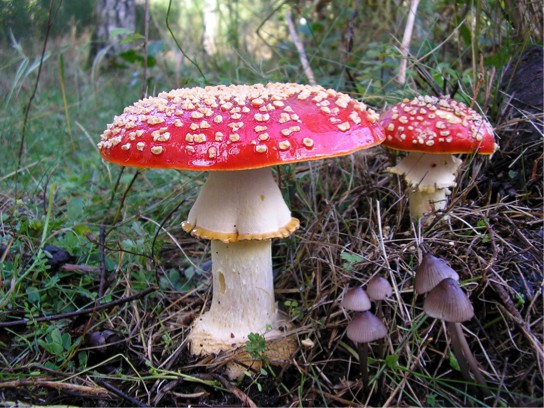
Like plant cells, fungal cells are surrounded by a thick cell wall; however, the rigid layers contain the complex polysaccharides chitin and glucan and not cellulose that is used by plants. Chitin, also found in the exoskeleton of insects, gives structural strength to the cell walls of fungi. The cell wall protects the cell from desiccation and predators. Fungi have plasma membranes similar to other eukaryotes, except that the structure is stabilized by ergosterol, a steroid molecule that functions like the cholesterol found in animal cell membranes. Most members of the kingdom Fungi are nonmotile. Flagella are produced only by the gametes in the primitive division Chytridiomycota.
Growth and Reproduction
The vegetative body of a fungus is called a thallus and can be unicellular or multicellular. Some fungi are dimorphic because they can go from being unicellular to multicellular depending on environmental conditions. Unicellular fungi are generally referred to as yeasts.Saccharomyces cerevisiae (baker’s yeast) and Candida species (the agents of thrush, a common fungal infection) are examples of unicellular fungi.
Most fungi are multicellular organisms. They display two distinct morphological stages: vegetative and reproductive. The vegetative stage is characterized by a tangle of slender thread-like structures called hyphae (singular, hypha), whereas the reproductive stage can be more conspicuous. A mass of hyphae is called a mycelium (Figure 13.22). It can grow on a surface, in soil or decaying material, in a liquid, or even in or on living tissue. Although individual hypha must be observed under a microscope, the mycelium of a fungus can be very large with some species truly being “the fungus humongous.” The giant Armillaria ostoyae (honey mushroom) is considered the largest organism on Earth, spreading across over 2,000 acres of underground soil in eastern Oregon; it is estimated to be at least 2,400 years old.
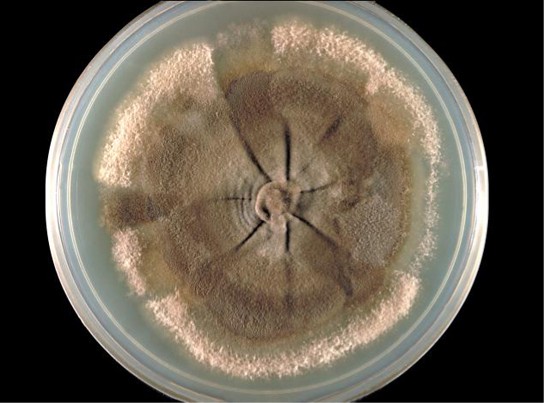
Most fungal hyphae are divided into separate cells by end walls called septa (singular, septum). In most divisions (like plants, fungal phyla are called divisions by tradition) of fungi, tiny holes in the septa allow for the rapid flow of nutrients and small molecules from cell to cell along the hyphae. They are described as perforated septa. The hyphae in bread molds (which belong to the division Zygomycota) are not separated by septa. They are formed of large cells containing many nuclei, an arrangement described as coenocytic hyphae.
Fungi thrive in environments that are moist and slightly acidic, and can grow with or without light. They vary in their oxygen requirements. Most fungi are obligate aerobes, requiring oxygen to survive. Other species, such as the Chytridiomycota that reside in the rumen of cattle, are obligate anaerobes, meaning that they cannot grow and reproduce in an environment with oxygen. Yeasts are intermediate: They grow best in the presence of oxygen but can use fermentation in the absence of oxygen. The alcohol produced from yeast fermentation is used in wine and beer production, and the carbon dioxide they produce carbonates beer and sparkling wine, and makes bread rise.
Fungi can reproduce sexually or asexually. In both sexual and asexual reproduction, fungi produce spores that disperse from the parent organism by either floating in the wind or hitching a ride on an animal. Fungal spores are smaller and lighter than plant seeds, but they are not usually released as high in the air. The giant puffball mushroom bursts open and releases trillions of spores: The huge number of spores released increases the likelihood of spores landing in an environment that will support growth (Figure 13.23).
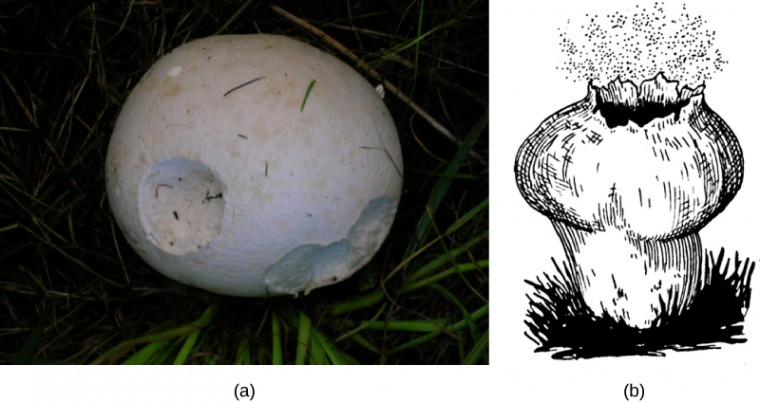
How Fungi Obtain Nutrition
Like animals, fungi are heterotrophs: They use complex organic compounds as a source of carbon rather than fixing carbon dioxide from the atmosphere, as some bacteria and most plants do. In addition, fungi do not fix nitrogen from the atmosphere. Like animals, they must obtain it from their diet. However, unlike most animals that ingest food and then digest it internally in specialized organs, fungi perform these steps in the reverse order. Digestion precedes ingestion. First, exoenzymes, enzymes that catalyze reactions on compounds outside of the cell, are transported out of the hyphae where they break down nutrients in the environment. Then, the smaller molecules produced by the external digestion are absorbed through the large surface areas of the mycelium. As with animal cells, the fungal storage polysaccharide is glycogen rather than starch, as found in plants.
Fungi are mostly saprobes, organisms that derive nutrients from decaying organic matter. They obtain their nutrients from dead or decomposing organic matter, mainly plant material. Fungal exoenzymes are able to break down insoluble polysaccharides, such as the cellulose and lignin of dead wood, into readily absorbable glucose molecules. Decomposers are important components of ecosystems, because they return nutrients locked in dead bodies to a form that is usable for other organisms. This role is discussed in more detail later. Because of their varied metabolic pathways, fungi fulfill an important ecological role and are being investigated as potential tools in bioremediation. For example, some species of fungi can be used to break down diesel oil and polycyclic aromatic hydrocarbons. Other species take up heavy metals such as cadmium and lead.
Fungal Diversity
The kingdom Fungi contains four major divisions that were established according to their mode of sexual reproduction. Polyphyletic, unrelated fungi that reproduce without a sexual cycle, are placed for convenience in a fifth division, and a sixth major fungal group that does not fit well with any of the previous five has recently been described. Not all mycologists agree with this scheme. Rapid advances in molecular biology and the sequencing of 18S rRNA (a component of ribosomes) continue to reveal new and different relationships between the various categories of fungi.
The traditional divisions of Fungi are the Chytridiomycota (chytrids), the Zygomycota (conjugated fungi), the Ascomycota (sac fungi), and the Basidiomycota (club fungi). An older classification scheme grouped fungi that strictly use asexual reproduction into Deuteromycota, a group that is no longer in use. The Glomeromycota belong to a newly described group (Figure 13.24).
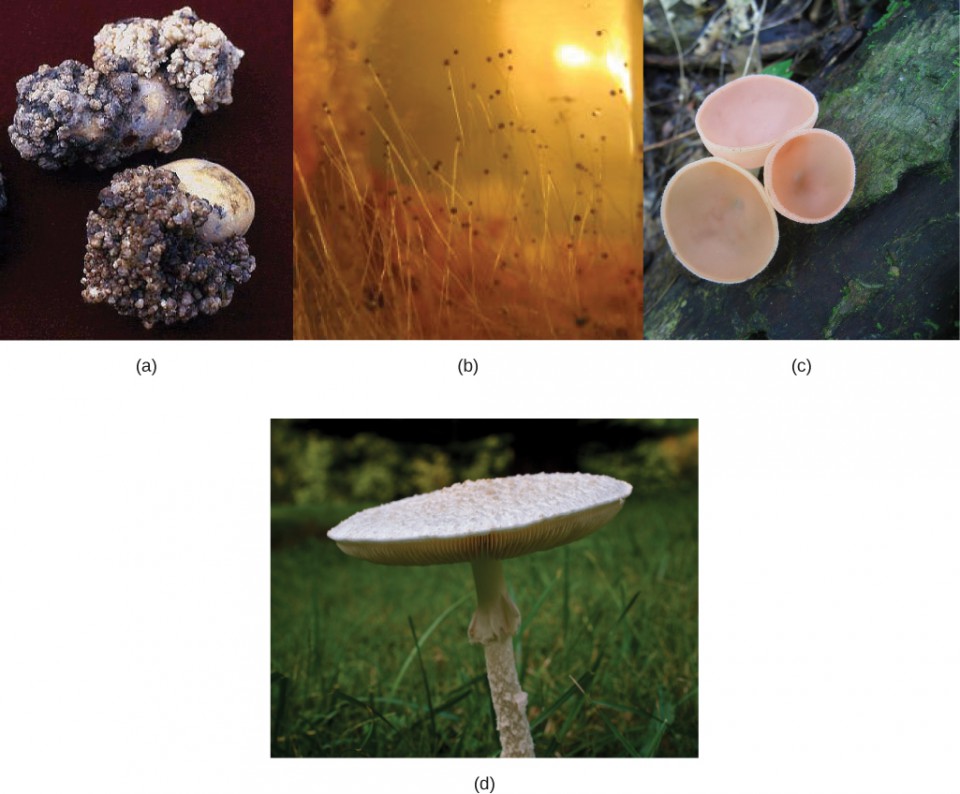
Pathogenic Fungi
Many fungi have negative impacts on other species, including humans and the organisms they depend on for food. Fungi may be parasites, pathogens, and, in a very few cases, predators.
Plant Parasites and Pathogens
The production of enough good-quality crops is essential to our existence. Plant diseases have ruined crops, bringing widespread famine. Most plant pathogens are fungi that cause tissue decay and eventual death of the host (Figure 13.25). In addition to destroying plant tissue directly, some plant pathogens spoil crops by producing potent toxins. Fungi are also responsible for food spoilage and the rotting of stored crops. For example, the fungus Claviceps purpurea causes ergot, a disease of cereal crops (especially of rye). Although the fungus reduces the yield of cereals, the effects of the ergot’s alkaloid toxins on humans and animals are of much greater significance: In animals, the disease is referred to as ergotism. The most common signs and symptoms are convulsions, hallucination, gangrene, and loss of milk in cattle. The active ingredient of ergot is lysergic acid, which is a precursor of the drug LSD. Smuts, rusts, and powdery or downy mildew are other examples of common fungal pathogens that affect crops.
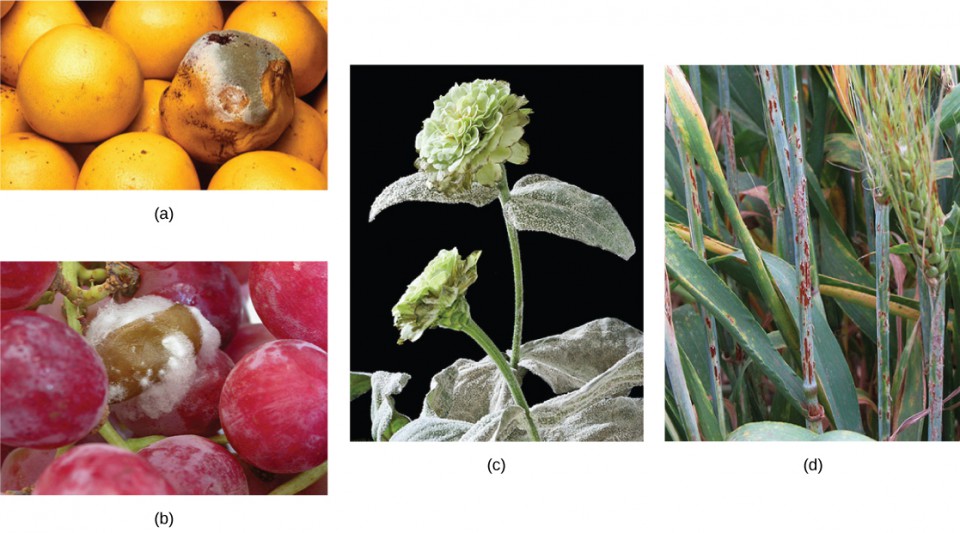
Aflatoxins are toxic and carcinogenic compounds released by fungi of the genus Aspergillus. Periodically, harvests of nuts and grains are tainted by aflatoxins, leading to massive recall of produce, sometimes ruining producers, and causing food shortages in developing countries.
Animal and Human Parasites and Pathogens
Fungi can affect animals, including humans, in several ways. Fungi attack animals directly by colonizing and destroying tissues. Humans and other animals can be poisoned by eating toxic mushrooms or foods contaminated by fungi. In addition, individuals who display hypersensitivity to molds and spores develop strong and dangerous allergic reactions. Fungal infections are generally very difficult to treat because, unlike bacteria, fungi are eukaryotes. Antibiotics only target prokaryotic cells, whereas compounds that kill fungi also adversely affect the eukaryotic animal host.
Many fungal infections (mycoses) are superficial and termed cutaneous (meaning “skin”) mycoses. They are usually visible on the skin of the animal. Fungi that cause the superficial mycoses of the epidermis, hair, and nails rarely spread to the underlying tissue (Figure 13.26). These fungi are often misnamed “dermatophytes” from the Greek dermis skin and phyte plant, but they are not plants. Dermatophytes are also called “ringworms” because of the red ring that they cause on skin (although the ring is caused by fungi, not a worm). These fungi secrete extracellular enzymes that break down keratin (a protein found in hair, skin, and nails), causing a number of conditions such as athlete’s foot, jock itch, and other cutaneous fungal infections. These conditions are usually treated with over-the-counter topical creams and powders, and are easily cleared. More persistent, superficial mycoses may require prescription oral medications.
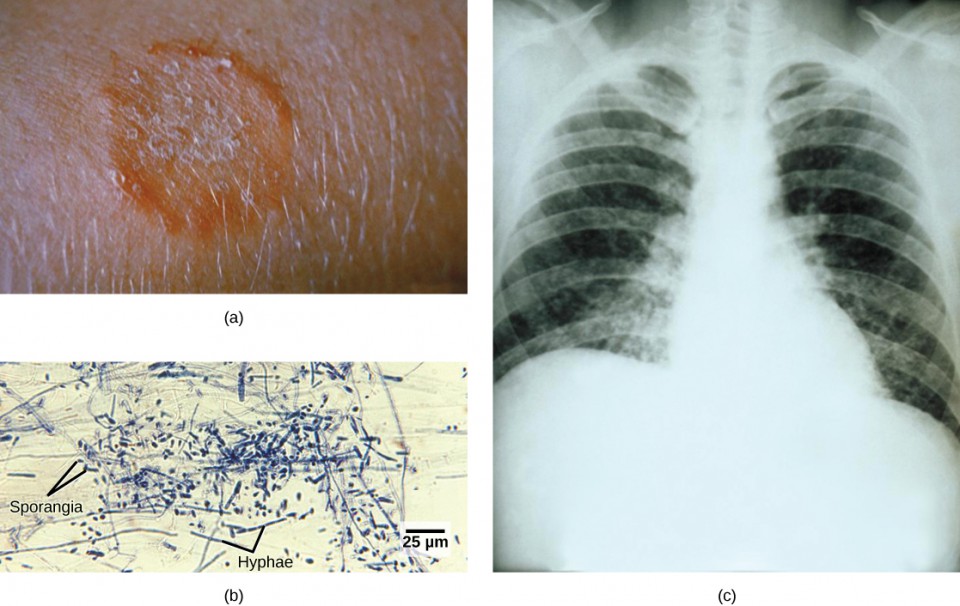
Systemic mycoses spread to internal organs, most commonly entering the body through the respiratory system. For example, coccidioidomycosis (valley fever) is commonly found in the southwestern United States, where the fungus resides in the dust. Once inhaled, the spores develop in the lungs and cause signs and symptoms similar to those of tuberculosis. Histoplasmosis (Figure 13.26c) is caused by the dimorphic fungus Histoplasma capsulatum; it causes pulmonary infections and, in rare cases, swelling of the membranes of the brain and spinal cord. Treatment of many fungal diseases requires the use of antifungal medications that have serious side effects.
Opportunistic mycoses are fungal infections that are either common in all environments or part of the normal biota. They affect mainly individuals who have a compromised immune system. Patients in the late stages of AIDS suffer from opportunistic mycoses, such as Pneumocystis, which can be life threatening. The yeast Candida spp., which is a common member of the natural biota, can grow unchecked if the pH, the immune defenses, or the normal population of bacteria is altered, causing yeast infections of the vagina or mouth (oral thrush).
Fungi may even take on a predatory lifestyle. In soil environments that are poor in nitrogen, some fungi resort to predation of nematodes (small roundworms). Species of Arthrobotrys fungi have a number of mechanisms to trap nematodes. For example, they have constricting rings within their network of hyphae. The rings swell when the nematode touches it and closes around the body of the nematode, thus trapping it. The fungus extends specialized hyphae that can penetrate the body of the worm and slowly digest the hapless prey.
Beneficial Fungi
Fungi play a crucial role in the balance of ecosystems. They colonize most habitats on Earth, preferring dark, moist conditions. They can thrive in seemingly hostile environments, such as the tundra, thanks to a most successful symbiosis with photosynthetic organisms, like lichens. Fungi are not obvious in the way that large animals or tall trees are. Yet, like bacteria, they are major decomposers of nature. With their versatile metabolism, fungi break down organic matter that is insoluble and would not be recycled otherwise.
Importance to Ecosystems
Food webs would be incomplete without organisms that decompose organic matter and fungi are key participants in this process. Decomposition allows for cycling of nutrients such as carbon, nitrogen, and phosphorus back into the environment so they are available to living things, rather than being trapped in dead organisms. Fungi are particularly important because they have evolved enzymes to break down cellulose and lignin, components of plant cell walls that few other organisms are able to digest, releasing their carbon content.
Fungi are also involved in ecologically important coevolved symbioses, both mutually beneficial and pathogenic with organisms from the other kingdoms. Mycorrhiza, a term combining the Greek roots myco meaning fungus and rhizo meaning root, refers to the association between vascular plant roots and their symbiotic fungi. Somewhere between 80–90 percent of all plant species have mycorrhizal partners. In a mycorrhizal association, the fungal mycelia use their extensive network of hyphae and large surface area in contact with the soil to channel water and minerals from the soil into the plant. In exchange, the plant supplies the products of photosynthesis to fuel the metabolism of the fungus. Ectomycorrhizae (“outside” mycorrhiza) depend on fungi enveloping the roots in a sheath (called a mantle) and a net of hyphae that extends into the roots between cells. In a second type, the Glomeromycota fungi form arbuscular mycorrhiza. In these mycorrhiza, the fungi form arbuscles, a specialized highly branched hypha, which penetrate root cells and are the sites of the metabolic exchanges between the fungus and the host plant. Orchids rely on a third type of mycorrhiza. Orchids form small seeds without much storage to sustain germination and growth. Their seeds will not germinate without a mycorrhizal partner (usually Basidiomycota). After nutrients in the seed are depleted, fungal symbionts support the growth of the orchid by providing necessary carbohydrates and minerals. Some orchids continue to be mycorrhizal throughout their lifecycle.
Lichens blanket many rocks and tree bark, displaying a range of colors and textures. Lichens are important pioneer organisms that colonize rock surfaces in otherwise lifeless environments such as are created by glacial recession. The lichen is able to leach nutrients from the rocks and break them down in the first step to creating soil. Lichens are also present in mature habitats on rock surfaces or the trunks of trees. They are an important food source for caribou. Lichens are not a single organism, but rather a fungus (usually an Ascomycota or Basidiomycota species) living in close contact with a photosynthetic organism (an alga or cyanobacterium). The body of a lichen, referred to as a thallus, is formed of hyphae wrapped around the green partner. The photosynthetic organism provides carbon and energy in the form of carbohydrates and receives protection from the elements by the thallus of the fungal partner. Some cyanobacteria fix nitrogen from the atmosphere, contributing nitrogenous compounds to the association. In return, the fungus supplies minerals and protection from dryness and excessive light by encasing the algae in its mycelium. The fungus also attaches the symbiotic organism to the substrate.
Fungi have evolved mutualistic associations with numerous arthropods. The association between species of Basidiomycota and scale insects is one example. The fungal mycelium covers and protects the insect colonies. The scale insects foster a flow of nutrients from the parasitized plant to the fungus. In a second example, leaf-cutting ants of Central and South America literally farm fungi. They cut disks of leaves from plants and pile them up in gardens. Fungi are cultivated in these gardens, digesting the cellulose that the ants cannot break down. Once smaller sugar molecules are produced and consumed by the fungi, they in turn become a meal for the ants. The insects also patrol their garden, preying on competing fungi. Both ants and fungi benefit from the association. The fungus receives a steady supply of leaves and freedom from competition, while the ants feed on the fungi they cultivate.
Importance to Humans
Although we often think of fungi as organisms that cause diseases and rot food, fungi are important to human life on many levels. As we have seen, they influence the well-being of human populations on a large scale because they help nutrients cycle in ecosystems. They have other ecosystem roles as well. For example, as animal pathogens, fungi help to control the population of damaging pests. These fungi are very specific to the insects they attack and do not infect other animals or plants. The potential to use fungi as microbial insecticides is being investigated, with several species already on the market. For example, the fungus Beauveria bassiana is a pesticide that is currently being tested as a possible biological control for the recent spread of emerald ash borer. It has been released in Michigan, Illinois, Indiana, Ohio, West Virginia, and Maryland.
The mycorrhizal relationship between fungi and plant roots is essential for the productivity of farmland. Without the fungal partner in the root systems, 80–90% of trees and grasses would not survive. Mycorrhizal fungal inoculants are available as soil amendments from gardening supply stores and promoted by supporters of organic agriculture.
We also eat some types of fungi. Mushrooms figure prominently in the human diet. Morels, shiitake mushrooms, chanterelles, and truffles are considered delicacies (Figure 13.27). The humble meadow mushroom, Agaricus campestris, appears in many dishes. Molds of the genus Penicillium ripen many cheeses. They originate in the natural environment such as the caves of Roquefort, France, where wheels of sheep milk cheese are stacked to capture the molds responsible for the blue veins and pungent taste of the cheese.
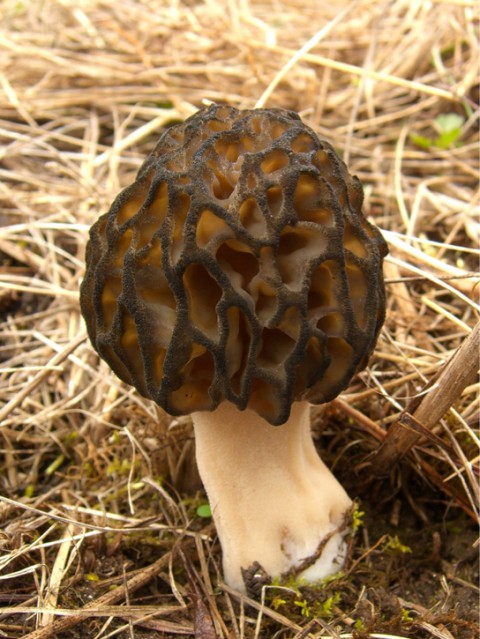
Fermentation—of grains to produce beer, and of fruits to produce wine—is an ancient art that humans in most cultures have practiced for millennia. Wild yeasts are acquired from the environment and used to ferment sugars into CO2 and ethyl alcohol under anaerobic conditions. It is now possible to purchase isolated strains of wild yeasts from different wine-making regions. Pasteur was instrumental in developing a reliable strain of brewer’s yeast, Saccharomyces cerevisiae, for the French brewing industry in the late 1850s. It was one of the first examples of biotechnology patenting. Yeast is also used to make breads that rise. The carbon dioxide they produce is responsible for the bubbles produced in the dough that become the air pockets of the baked bread.
Many secondary metabolites of fungi are of great commercial importance. Antibiotics are naturally produced by fungi to kill or inhibit the growth of bacteria, and limit competition in the natural environment. Valuable drugs isolated from fungi include the immunosuppressant drug cyclosporine (which reduces the risk of rejection after organ transplant), the precursors of steroid hormones, and ergot alkaloids used to stop bleeding. In addition, as easily cultured eukaryotic organisms, some fungi are important model research organisms including the red bread mold Neurospora crassa and the yeast, S. cerevisiae.
Section Summary
Fungi are eukaryotic organisms that appeared on land over 450 million years ago. They are heterotrophs and contain neither photosynthetic pigments such as chlorophylls nor organelles such as chloroplasts. Because they feed on decaying and dead matter, they are saprobes. Fungi are important decomposers and release essential elements into the environment. External enzymes digest nutrients that are absorbed by the body of the fungus called a thallus. A thick cell wall made of chitin surrounds the cell. Fungi can be unicellular as yeasts or develop a network of filaments called a mycelium, often described as mold. Most species multiply by asexual and sexual reproductive cycles, and display an alternation of generations.
The divisions of fungi are the Chytridiomycota, Zygomycota, Ascomycota, Basidiomycota, Glomeromycota, and the Deuteromycota, a polyphyletic group.
Fungi establish parasitic relationships with plants and animals. Fungal diseases can decimate crops and spoil food during storage. Compounds produced by fungi can be toxic to humans and other animals. Mycoses are infections caused by fungi. Superficial mycoses affect the skin, whereas systemic mycoses spread through the body. Fungal infections are difficult to cure.
Fungi have colonized all environments on Earth but are most often found in cool, dark, moist places with a supply of decaying material. Fungi are important decomposers because they are saprobes. Many successful mutualistic relationships involve a fungus and another organism. They establish complex mycorrhizal associations with the roots of plants. Lichens are a symbiotic relationship between a fungus and a photosynthetic organism, usually an alga or cyanobacterium.
Fungi are important to everyday human life. Fungi are important decomposers in most ecosystems. Mycorrhizal fungi are essential for the growth of most plants. Fungi, as food, play a role in human nutrition in the form of mushrooms and as agents of fermentation in the production of bread, cheeses, alcoholic beverages, and numerous other food preparations. Secondary metabolites of fungi are used in medicine as antibiotics and anticoagulants. Fungi are used in research as model organisms for the study of eukaryotic genetics and metabolism.
Exercises
Glossary
- Ascomycota: (sac fungi) a division of fungi that store spores in a sac called ascus
- basidiomycota: (club fungi) a division of fungi that produce club shaped structures, basidia, which contain spores
- Chytridiomycota: (chytrids) a primitive division of fungi that live in water and produce gametes with flagella
- Deuteromycota: a division of fungi that do not have a known sexual reproductive cycle (presently members of two phyla: Ascomycota and Basidiomycota)
- Glomeromycota: a group of fungi that form symbiotic relationships with the roots of trees
- hypha: a fungal filament composed of one or more cells
- lichen: the close association of a fungus with a photosynthetic alga or bacterium that benefits both partners
- mold: a tangle of visible mycelia with a fuzzy appearance
- mycelium: a mass of fungal hyphae
- mycorrhiza: a mutualistic association between fungi and vascular plant roots
- mycosis: a fungal infection
- septum: the cell wall division between hyphae
- thallus: a vegetative body of a fungus
- yeast: a general term used to describe unicellular fungi
- Zygomycota: (conjugated fungi) the division of fungi that form a zygote contained in a zygospore
Media Attributions
- Figure 13.20 © (a) Modification of work by Chris Wee; (b) Modification of work by Cory Zanker; (c) Modification of work by Janice Haney Carr, Robert Simmons, CDC; scale-bar data from Matt Russell; OpenStax is licensed under a CC BY (Attribution) license
- Figure 13.21 © Christine Majul; OpenStax is licensed under a CC BY (Attribution) license
- Figure 13.22 © CDC; OpenStax is licensed under a CC BY (Attribution) license
- Figure 13.23 © (a) Modification of work by Roger Griffith; (b) Modification of work by Pearson Scott Foresman, donated to the Wikimedia Foundation; OpenStax is licensed under a CC BY (Attribution) license
- Figure 13.24 © (a) Modification of work by USDA APHIS PPQ; (c) Modification of work by "icelight"/Flickr; (c) Modification of work by Cory Zanker; OpenStax is licensed under a CC BY (Attribution) license
- Figure 13.25 © (a) Modification of work by Scott Bauer, USDA ARS; (b) Modification of work by Stephen Ausmus, USDA ARS; (c) Modification of work by David Marshall, USDA ARS; (d) Modification of work by Joseph Smilanick, USDA ARS; OpenStax is licensed under a CC BY (Attribution) license
- Figure 13.26 © (a, b) Modification of work by Dr. Lucille K. Georg, CDC; (c) Modification of work by M Renz, CDC; scale-bar data from Matt Russell; OpenStax is licensed under a CC BY (Attribution) license
- Figure 13.27 © Jason Hollinger; OpenStax is licensed under a CC BY (Attribution) license

